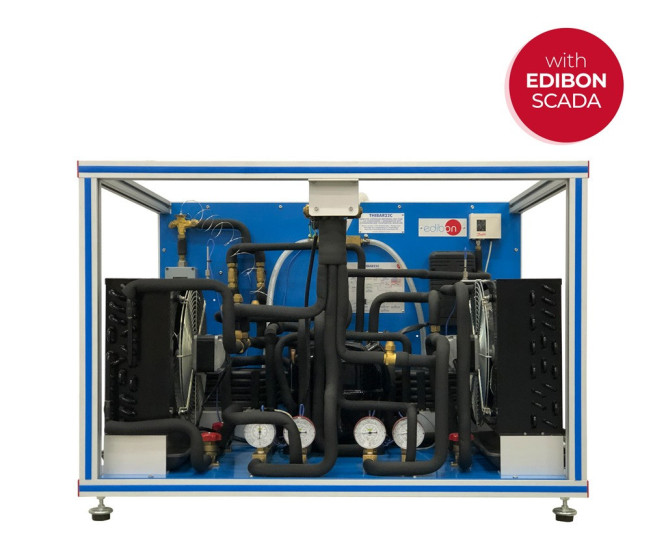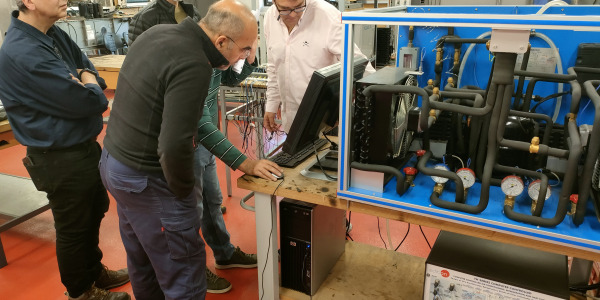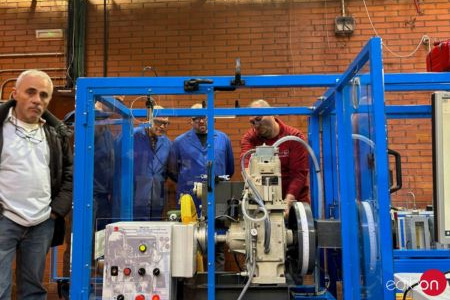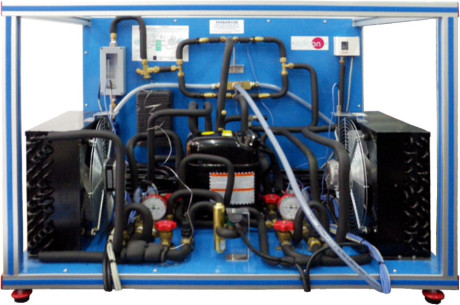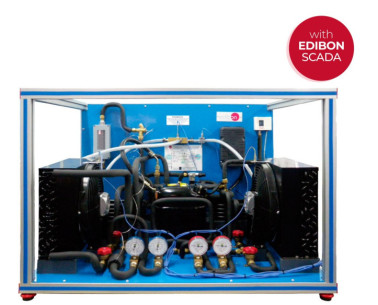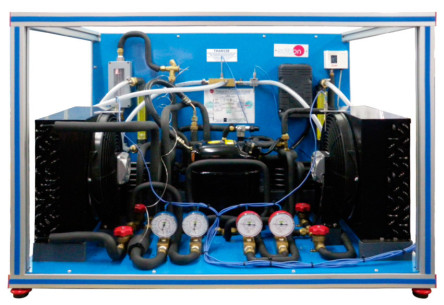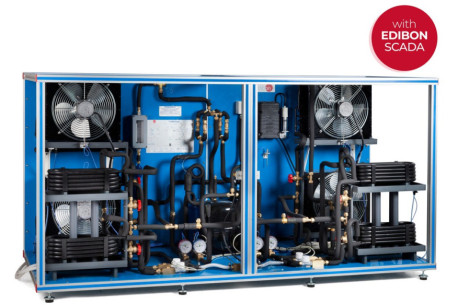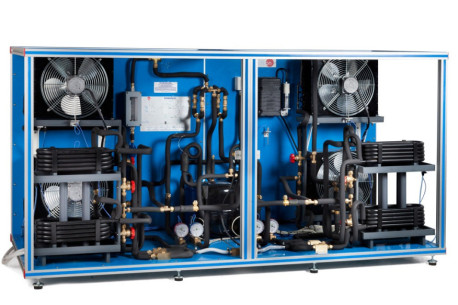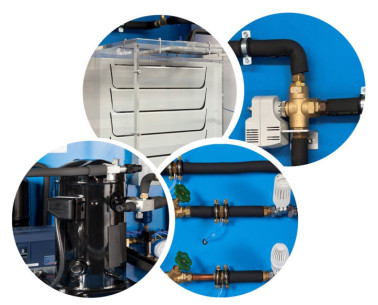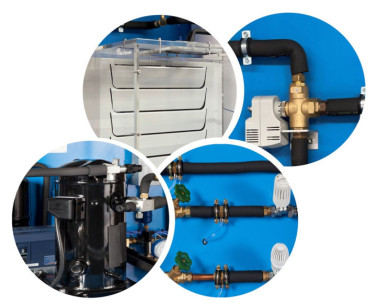THIBAR22C Bomba de Calor + Ar Condicionado + Refrigeração Reversível com 2 condensadores e 2 evaporadores (Água/Ar), Controlado por PC
SISTEMAS INOVADORES
The unit "THIBAR22C" has as aim introduce the student to the study of the heat pumps, air conditioning and refrigeration, as well as the analysis and determination of the operation typical parameters of the unit depending on the two types of fluids used in the processes of evaporation and condensation (air and water).
Expansões
LABORATÓRIOS
NOTÍCIAS RELACIONADAS
Descrição Geral
The Computer Controlled Rerversible Heat Pump + Air Conditioning + Refrigeration with 2 Condensers and 2 Evaporators (Water/Air),"THIBAR22C", has as aim introduce the student to the study of the heat pumps, air conditioning and refrigeration, as well as the analysisand determination of the operation typical parameters of the unit depending on the two types of fluids used in the processes of evaporationand condensation (air and water).
This unit can have different applications, depending on the type of cold focus or hot focusused in the processes of evaporation and condensation. This unit consists of the followingstages:
- Compression: This stage begins when the coolant enters to the compressor. This coolant is compressed, increasing its pressure and temperature. To measure these variables the unit includes a pressure sensor, a manometer and a temperature sensor.
- Condensation: The coolant has two possibilities: divert the coolant through the air condenser, or through the water condenser. The coolant transfers its heat to the water (or to the air) that flows for the condenser. At the end of this stage, the pressure and the temperature of the coolant are measured by means of a manometer and a temperature sensor.
- Expansion: The coolant circulates through an accumulator and a filter, to retain particles of condensate, and a flow sensor. Next it circulates through the valve of expansion, which causes a fall of pressure and temperature of the coolant. At the end of this stage, the pressure and the temperature of the coolant are measured by means of a manometer and temperature sensor.
- Evaporation: The coolant has two possibilities: divert the coolant through the air evaporator, or through the water evaporator. The coolant absorbs the heat of the water (or the air) that flows for the evaporator. At the end of this stage, the pressure and the temperature of the coolant are measured by means of a pressure sensor, a manometer and a temperature sensor. Finally, the coolant circulates through a liquid separator to retain liquid particles before going on to the compressor.
The condensers and evaporators have different sensors to the measure of the most important parameters (temperatures and flows). In addition, the unit includes a high pressure control to avoid an excess of pressure in the unit and a 4-way valve to change the direction of the coolant.
The 4-way valve (or cycle inversion valve) allows to obtain different combinations of Heat Pump, Air Conditioning and Refrigeration in a only unit.So that using the cycle inversion valve, we have 9 units in one, 6 of them Heat Pump + Air Conditioning + Refrigeration and 3 of them Heat Pump + Air Conditioning.
This Computer Controlled Unit is supplied with the EDIBON Computer Control System (SCADA), and includes: The unit itself + a Control Interface Box + a Data Acquisition Board + Computer Control, Data Acquisition and Management Software Packages, for controlling the process and all parameters involved in the process.
EXERCÍCIOS E PRÁTICAS GUIADAS
EXERCÍCIOS PRÁTICOS GUIADOS INCLUÍDOS NO MANUAL
- Determination of COP (coefficient of performance) of a heat pump. Water as heat source. (Water-water heat pump).
- Determination of COP (coefficient of performance) of a heat pump. Air as heat source. (Water-air heat pump).
- Determination of COP (coefficient of performance) of a heat pump. Air as heat source. (Air-air heat pump).
- Determination of COP (coefficient of performance) of a heat pump. Water as heat source. (Air-water heat pump).
- Representation of performance curves of the heat pump with different inlet and outlet temperatures. Water as heat source. (Water-water heat pump).
- Representation of performance curves of the heat pump with different inlet and outlet temperatures. Air as heat source. (Water-air heat pump).
- Representation of performance curves of the heat pump with different inlet and outlet temperatures. Water as heat source. (Air-water heat pump).
- Representation of performance curves of the heat pump with different inlet and outlet temperatures. Air as heat source. (Airair heat pump).
- Lay out of the refrigeration compression cycle in a diagram P-H and comparison with the ideal cycle. Water as heat source. (Water-water heat pump).
- Lay out of the refrigeration compression cycle in a diagram P-H and comparison with the ideal cycle. Air as heat source. (Waterair heat pump).
- Lay out of the refrigeration compression cycle in a diagram P-H and comparison with the ideal cycle. Water as heat source. (Airwater heat pump).
- Lay out of the refrigeration compression cycle in a diagram P-H and comparison with the ideal cycle. Air as heat source. (Air-air heat pump).
- Representation of the performance curves of the heat pump based on the properties of the refrigerant and at different condensation and evaporation temperatures. Water as heat source. (Water-water heat pump).
- Representation of the performance curves of the heat pump based on the properties of the refrigerant and at different condensation and evaporation temperatures. Air as heat source. (Water-air heat pump).
- Representation of the performance curves of the heat pump based on the properties of the refrigerant and at different condensation and evaporation temperatures. Water as heat source. (Air-water heat pump).
- Representation of the performance curves of the heat pump based on the properties of the refrigerant and at different condensation and evaporation temperatures. Air as heat source. (Air-air heat pump).
- Practices with cycle inversion.
- Sensors calibration.
EXERCÍCIOS MAIS PRÁTICOS A SEREM FEITOS COM A UNIDADE
- Properties of the refrigerant R-513a.
- Enthalpy-Pressure diagram for the refrigerant R-513a.
Other possibilities to be done with this Unit:
- Many students view results simultaneously. To view all results in real time in the classroom by means of a projector or an electronic whiteboard.
- Open Control, Multicontrol and Real Time Control. This unit allows intrinsically and/or extrinsically to change the span, gains, proportional, integral, derivative parameters, etc, in real time.
- The Computer Control System with SCADA and PID Control allow a real industrial simulation.
- This unit is totally safe as uses mechanical, electrical and electronic, and software safety devices.
- This unit can be used for doing applied research.
- This unit can be used for giving training courses to Industries even to other Technical Education Institutions.
- Control of the THIBAR22C unit process through the control interface box without the computer.
- Visualization of all the sensors values used in the THIBAR22C unit process.
- By using PLC-PI additional 19 more exercises can be done.
- Several other exercises can be done and designed by the user.
EQUIPAMENTOS SIMILARES DISPONÍVEIS
Bomba de Calor + Ar Condicionado + Refrigeração com 2 Condensadores e 2 Evaporadores (Água/Ar), Controlado por PC
Bomba de Calor + Ar Condicionado + Refrigeração com 2 Condensadores e 2 Evaporadores (Água/Ar)
Bomba de Calor + Ar Condicionado + Refrigeração Reversível com 4 condensadores e 4 evaporadores (Água/Ar), Controlado por PC
Bomba de Calor + Ar Condicionado + Refrigeração Reversível com 4 condensadores e 4 evaporadores (Água/Ar)
EQUIPAMENTOS COMPLEMENTARES
Bomba de Calor + Ar Condicionado + Refrigeração Reversível com 2 condensadores e 2 evaporadores (Água/Ar)
Bomba de Calor + Ar Condicionado + Refrigeração Reversível com 4 condensadores e 4 evaporadores (Água/Ar), Controlado por PC
Bomba de Calor + Ar Condicionado + Refrigeração Reversível com 4 condensadores e 4 evaporadores (Água/Ar)
Bomba de Calor + Ar Condicionado + Refrigeração com 2 Condensadores e 2 Evaporadores (Água/Ar), Controlado por PC
Bomba de Calor + Ar Condicionado + Refrigeração com 2 Condensadores e 2 Evaporadores (Água/Ar)
Bomba de Calor para Distintas Fontes e Trocadores de Calor
Piso Aquecido e/ou Fonte de Calor para Bomba de Calor
Aquecimento de Ar e/ou Trocador de Ar
Qualidade

Serviço pós-venda

 Preferências de cookies
Preferências de cookies

